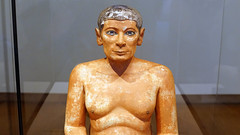
Not only do we pay for our servers, but also for related services such as our content delivery network, Google Workspace, email, and much more. One additional fact in favor of the earlier date is that the statue is represented in writing' position while it seems that scribes from the period after the 5th dynasty have been portrayed mainly in 'reading' position' (Wikipedia article on The Seated Scribe, accessed 10-10-2013). Server Costs Fundraiser 2023 Running a website with millions of readers every month is expensive. The nipples are marked with two wooden stubs.The dating itself remains uncertain the period of the 6th dynasty has also been suggested. The Seated Scribe is an Old Kingdom sculpture from the Saqqara Necropolis, which houses the Djoser step pyramid. It seems that the right hand was holding a brush, now missing. Hands, fingers, and fingernails of the sculpture are delicately modeled. Its realistic features stand in contrast to perhaps more rigid and somewhat less detailed body. It represents a figure of a seated scribe at work.
The seated scribe free#
Perhaps the most striking part aspect of the figure is its face. The Seated Scribe From Wikipedia the free encyclopedia The sculpture of the Seated Scribe or Squatting Scribe is a famous work of ancient Egyptian art. "The figure is dressed in a white kilt stretched to its knees. Calcaire peint, yeux en cuivre incrust de cristal de roche, IVe ou Ve dynastie d'gypte, 2600-2350 av.

The sculpture is preserved in the Louvre. Painted limestone, eyes inlaid with rock crystal in copper, 4th of 5th dynasty of Egypt, 26002350 BC.

It has been dated to the 4th Dynasty, 2620–2500 BCE. Google Arts & Culture features content from over 2000 leading museums and archives who have partnered with the Google Cultural Institute to bring the. The precise location remains unknown, as the document describing these excavations was published posthumously and the original excavation journal has been lost. The Seated Scribe or Squatting Scribe, a painted limestone sculpture of a seated scribe at work, was discovered by French archaeologist Auguste Mariette in 1850 at Saqqara, a vast burial ground in Egypt. The sculpture of the seated scribe was discovered in Saqqara on 19 November 1850, to the north of the Serapeum 's line of sphinxes by French archeologist Auguste Mariette.


 0 kommentar(er)
0 kommentar(er)
